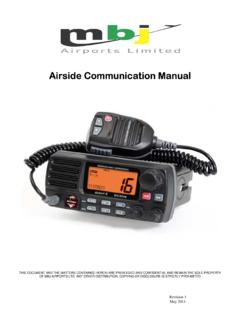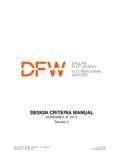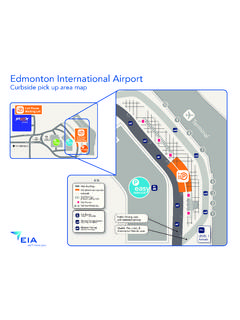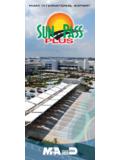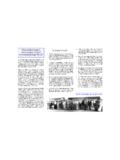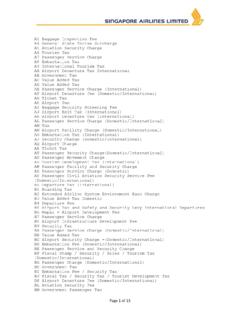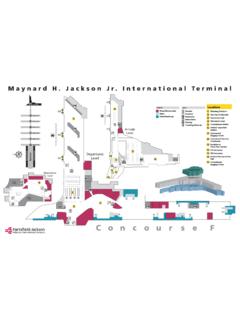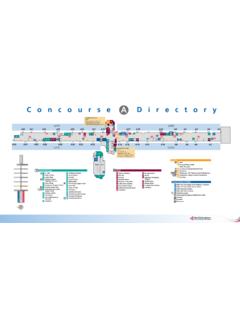Transcription of FOD Awareness - Sangster International Airport
1 FOD Awareness 1 What is FOD? Foreign Object Debris (FOD) can be as simple as a nut, a piece of concrete, a piece of paper, a stone, a suitcase handle, a screwdriver or a passenger. Throwaway items are inherently dangerous. In the working environment of an apron, they contribute to the damage or potential damage to aircraft, ground equipment and perhaps even endanger life. Foreign Object Debris can lead to Foreign Object Damage. Examples of FOD Aircraft parts, rocks, broken pavement, ramp equipment, and vehicle parts: Damage usually occurs when the aircraft is taking off or landing. The intake suction from a jet engine is powerful enough to suck up loose material lying on the runway, and the winds created by a helicopter or prop-driven aircraft's rotors or by a jet blast can send such objects airborne, creating hazards to nearby personnel.
2 Parts from ground vehicles Garbage, maintenance tools, etc. mistakenly or purposely deposited on tarmac and/or runway surfaces. Hail can break windshields and damage or stop engines. Ice on the wings, propellers, or engine intakes Dust or ash clogging the air intakes (as in sandstorms in desert operating conditions or ash clouds in volcanic eruptions). Tools, bolts, metal shavings, lock wire, etc. mistakenly left behind inside aircraft during the manufacturing process or maintenance. Generally speaking, bird strikes (when an aero plane flies into a bird, the impact can cause severe damage from a bird striking the fuselage, engine, etc) are not considered to be FOD strikes, unless the bird or wildlife was already dead and lying on the operating surface when the strike occurred.
3 Bird strikes are treated separately. All aircraft occasionally lose small metal or carbon parts during takeoff and landing. These parts remain on the runway and can cause damage to tires of other aircraft, hit the fuselage or windshield/canopy, or get sucked up into an engine. Although Airport ground crews regularly clean up runways, the crash of Air France Flight 4590 demonstrated that accidents can still occur: in that case, the crash was said to have been caused by debris left by a flight that had departed only four minutes earlier. On aircraft carriers, as well as military and some civilian airfields, sweeps are conducted before flight operations begin. A line of crewmen walk shoulder to shoulder along the flight operations surfaces, searching for and removing any foreign objects.
4 The objects removed are often also referred to as "FOD" although they haven't caused any damage. In this context a more appropriate translation of the acronym would be "foreign objects and debris". FOD Awareness 2In the case of the downed Air France Concorde in 2000, the source of FOD was from another aircraft. Air France sues over Concorde "Air France today launched legal action against Continental Airlines for sparking the tragic chain of events that caused its Concorde crash, in which 113 people died. French accident investigators believe a 16-inch-long shard of metal that fell from a Continental DC-10 jet on the runway of Paris's Charles de Gaulle Airport was at the origin of the July 25 disaster. The suit was based on an article in the civil aviation code that "makes a carrier fully responsible for objects which fall from its planes", an airline spokeswoman said.
5 Preliminary results of the official enquiry by France's BEA air accident investigators suggest the crash was caused by a metal strip left on the runway, which then caused a tyre blow-out and a chain reaction leading to a fire engulfing the plane's left side. The plane spun out of control as the pilot tried to land at a nearby airfield, crashing into a hotel in the Airport town of Gonesse. BEA investigators also discovered a piece similar to the strip was missing from a DC-10 belonging to Continental Airlines flight COA55, which took off from Charles de Gaulle Airport for Newark, New Jersey, shortly before Concorde. In a statement earlier this month, Continental admitted French and US experts inspecting the DC-1O had found that a piece "of a similar shape" to one found on the runway was missing from the plane.
6 Continental Airlines has not issued a statement concerning the Air France or German legal actions." (Source: Associated Newspapers, Ltd., Sept. 28, 2000) FOD Awareness 3 Foreign Object Debris and Damage Prevention Foreign object debris (FOD) at airports can cause damage that costs airlines, airports, and Airport tenants millions of dollars every year. FOD is any object that does not belong in or near airplanes and, as a result, can injure Airport or airline personnel and damage airplanes. A FOD-prevention program of training, facility inspection, maintenance, and coordination between all affected parties can minimize FOD and its effects. Foreign object debris (FOD) at airports includes any object found in an inappropriate location that -- as a result of being in that location -- can damage equipment, airplane or injure Airport personnel.
7 The resulting damage is estimated to cost the aerospace industry $4 billion a year. Airports, airlines, and Airport tenants can reduce this cost by taking steps to prevent Airport includes a wide range of material, including loose hardware, pavement fragments, catering supplies, building materials, rocks, sand, pieces of luggage, and even wildlife. FOD is found at terminal gates, cargo aprons, taxiways, runways, and run-up pads. It causes damage through direct contact with airplanes, such as by cutting airplane tires or being ingested into engines, or as a result of being thrown by jet blast and damaging airplanes or injuring people. A program to control Airport FOD is most effective when it addresses four main areas: (i)TRAINING All Airport personnel should receive training in the identification and elimination of FOD, including the potential consequences of ignoring it.
8 Effective training should stress employee and passenger safety, the hazards to equipment, the direct costs associated with FOD damage, and the indirect costs associated with flight delays and rescheduling. It should also include procedures for removing and eliminating FOD at its source, and should be reinforced through the use of posters and signs. Recurrent training is necessary to help maintain an Awareness of FOD. Training is a tremendous Awareness tool that is not always given the priority and forethought it deserves. It is an opportunity to highlight areas needing improvement, reinforce some of the rules that are not always being adhered to, introduce new initiatives, and applaud accomplishments. FOD Awareness 4 For instance, elements of new employee training should include: The definition of FOD.
9 Don t assume everyone knows what Foreign Object Damage is. Show photos of FOD and pass around samples of debris found at your facility. Identify the FOD SOP (Standard Operating Procedure) and provide a copy of the FOD procedure to each new employee. Emphasize the importance of Clean-As-You-Go and define the rules that apply to daily work routines. Review tool and hardware rules, to include tool crib issued items. Review the Missing Item Report, when to use it and how to submit it. Identify FOD control areas. Show examples of typical FOD charts/metrics. If a borescope is available at your site, discuss who may use it, and general safety rules. Also identify other specialized tools used to locate or remove foreign objects. Explain the role of the FOD department and how to contact a representative if needed.
10 Put out the Welcome Mat. Formal certification in FOD elimination covers knowledge of the following areas: Basic Terms & definitions Housekeeping Tool Accountability Hardware Accountability Lost Items Physical Entry & Personnel Control Reporting & Investigating Material Handling Parts Protections Hazardous Materials Wildlife / Environment FOD Effects. (ii)INSPECTION Airline personnel, when feasible, should join the Airport staff in daily airside inspections. This practice helps increase familiarity with local airfield conditions, and promotes effective communication between the Airport and airlines. The International Civil Aviation Organization (ICAO) require a daily, daylight inspection of airplane maneuvering areas and removal of FOD.


